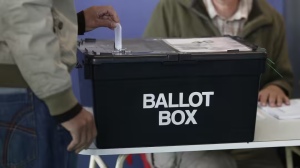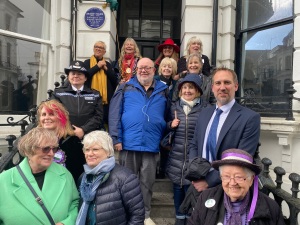(This item first appeared in the Brighton Argus on 8th May 2024)
Two hundred years ago today, the foundation stone for St Peter’s Church in Brighton was laid at “the entrance to the town”, now the city centre in York Place. The church was formally consecrated (declare sacred) and opened for business in January 1828.
This coming Sunday (12th May) there will be a service at 10.30am to celebrate this 200th anniversary.
 I first attended St Peter’s 45 years ago shortly after I had arrived in England. I didn’t become a regular attender as I wasn’t keen on the style of worship at that time. The vicar in 1979 was Canon John Hester who had close links with the entertainment industry. He was a friend of Peter Sellers who had originally found fame in The Goon Show, and was godfather to Victoria, the daughter of Sellers and Britt Ekland. Canon Hester also officiated at Sellers’ funeral in 1980 where he introduced ‘In The Mood’, saying that it was a piece of music that must have meant a great deal to Peter as he had left a specific instruction that it should be played at his funeral. He was surprised when the congregation burst into laughter as he had not known that Sellers actually detested ‘In The Mood’ saying he wouldn’t personally have to endure it if played at his own funeral. My wife has made a similar request that the ‘Match of the Day’ theme be played at her funeral!
I first attended St Peter’s 45 years ago shortly after I had arrived in England. I didn’t become a regular attender as I wasn’t keen on the style of worship at that time. The vicar in 1979 was Canon John Hester who had close links with the entertainment industry. He was a friend of Peter Sellers who had originally found fame in The Goon Show, and was godfather to Victoria, the daughter of Sellers and Britt Ekland. Canon Hester also officiated at Sellers’ funeral in 1980 where he introduced ‘In The Mood’, saying that it was a piece of music that must have meant a great deal to Peter as he had left a specific instruction that it should be played at his funeral. He was surprised when the congregation burst into laughter as he had not known that Sellers actually detested ‘In The Mood’ saying he wouldn’t personally have to endure it if played at his own funeral. My wife has made a similar request that the ‘Match of the Day’ theme be played at her funeral!
Canon Dominic Walker succeed John Hester as the Vicar of St Peter’s. Under his pastoral care, the church flourished. Dominic, who is our daughter’s godfather, was able to draw in many people for whom the church would otherwise have had little relevance. He held services for animals, a humanist memorial service for an atheist, and vigils for people who had died while being homeless and for the victims of domestic violence. He allowed a meeting to be held in support of striking miners, and he supported a councillor who was facing disciplinary action by her own party. Midnight Mass on Christmas Eve was always rammed to the rafters even if the more inebriated worshippers needed a police presence to keep the peace! He was on the Board of Brighton Housing Trust for many years, a member of the Labour Party, and active in the Christian Socialist Movement. At the same time he was a close friend of Sir Andrew Bowden, the Conservative MP for Brighton Kemptown and, together, they participated in a demonstration at Shoreham Harbour against live animal exports.
After Dominic was appointed Bishop of Reading in 1997, St Peter’s seemed to lose its way and the Diocese seemed determined to close it as a place of worship. A campaign was launched to save St Peter’s, led by my wife, Jean Calder, along with Isabel Turner and others. Over several months our teenage daughter, Clare, collected signatures in London Road to save the church. She spoke to many dozens of people who told her what St Peter’s meant to them and their families, how their parents and grandparents had been married there, and that they had been baptised at the church. St Peter’s runs through the family history of many old Brighton families.
Thanks to that campaign, St Peter’s did find a future as a place of worship when it partnered with Holy Trinity Brompton in London. A new priest, Archie Coates, arrived. Together with his wife, Sam, curate Johnnie Gumbell and Johnnie’s wife, Tara, a new congregation was built and St Peter’s is, once again, a thriving church community. I have to confess that I’m not keen on its current style of worship. I’m more of a “Be still and know that I am God” (Psalm 46) type of believer than a “Praise Him with loud cymbals” (Psalm 150) type.
When Archie arrived he came to see me in my previous role as chief executive of Brighton Housing Trust. He said that he was keen to do work in the community. My advice was to avoid doing anything about drugs or homelessness since there were already too many such services locally, and to focus the church’s work on people who were poor and/or lonely. He said my advice was helpful. Three weeks later he announced that St Peter’s would be setting up a homeless drug project! I am glad he ignored my advice because St Peter’s has filled a gap, particularly for homeless women or those with addictions.
For 200 years St Peter’s has touched and improved the lives of so many people. Here’s to the next 200.










